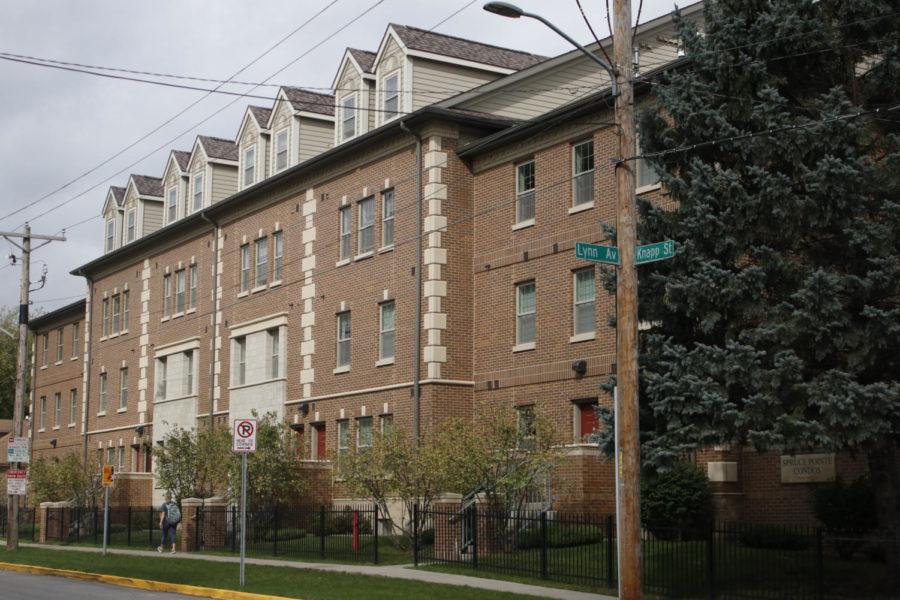Guest Column: Neighborhoods benefit from Rental Cap
Gillian Holte/Iowa State Daily
Apartments on Knapp Street.
April 10, 2019
This column was first published in the Des Moines Register on the 26th of March 2019.
We write in response to Steve Sherman’s recent guest column [Legislation supports homeowners’ property rights, curbs rental caps]. We have been involved in Ames’ rental cap process from its inception and want to make clear why near-campus neighborhoods, the only ones in Iowa subject to rental caps, are unique and worth fighting to preserve.
We question the Legislature’s interference (i.e., Senate File 447 and House File 718) in what has traditionally been a matter for local legislation: allowable property uses in single-family neighborhoods.
We have all lived in the South Campus neighborhood for over 30 years. It’s a wonderful place to live, within walking distance to Iowa State, Campustown and university facilities. Homes in this historic neighborhood are 80-100 years old and represent a wide variety of architectural styles. Many residents have lived here for decades and young people are buying homes as older residents begin to move away. Our homes might be worth more if sold for rental, but this is not what motivates those who fought for and want to preserve the rental cap.
This neighborhood has always been a mix of owner-occupied and rental, with the vast majority of renters being students. The critical issue is the balance between these uses. In the past few years, we have watched owner-occupied homes turn to rentals with alarming frequency. Rentals now exceed 40 percent of all properties in our neighborhood.
Neighborhoods like ours are goldmines for those seeking investment in student housing, but are also a source of affordable homes for those who work and want to live in Ames. Converting these homes to rentals removes them from the stock of affordable housing, already in short supply. In fact, homes have been selling quickly since conversion of owner-occupied to rental has been prohibited.
So, what is the problem with increased student rentals? It is not merely an issue of enforcement as Realtors like Mr. Sherman insist. First of all, enforcement in Ames is complaint-driven; this puts residents in the awkward and “non-neighborly” position of being monitors. Nor is every nuisance a reportable offense.
Just walk or drive early in the morning on streets near campus, outside our neighborhood, that are 100 percent rental. They are instantly identifiable from appearance alone as different from those streets with more of a balance. You’ll see unattractive yards, mud next to driveways where cars have driven, trash, garbage pails overflowing and left on the curb, broken screens and cups and cans from the party last night. These streets have declined as resident homeowners were driven away; no one was left to report problems. These are the streets where the VEISHEA riots started. We do not want our neighborhoods to suffer the same fate.
Of course, many student renters are well-behaved and responsible. But their stay in any neighborhood is short; the long-term bonds that are the fabric of a healthy neighborhood simply cannot be formed.
This issue comes down to a conflict we see at every level of government: short-term individual financial gain versus long-term good of the community. This helps explain why, from the start, the most vocal opposition to a rental cap in Ames came not from homeowners who overwhelmingly supported the cap but from the Realtor community — individuals who don’t live in our neighborhoods. In contrast, and to its credit, the Ames City Council clearly saw the value of preserving the stability of these neighborhoods. The council considered the quality of life for those who remain versus the potential profit of those who leave and chose preserving vibrant neighborhoods over ensuring maximum profit.
Ames worked for many months to craft its rental cap, including various exemptions and exceptions to minimize any potential financial harm. One such exception deals with difficulty in selling a home that is surrounded on at least three sides by rentals. The need for such an exception is proof that, once the balance has sufficiently shifted, potential purchasers will not want to live in these homes. Without the cap, more and more homes will be in this very situation. This is how to destroy a beautiful, historic neighborhood.
Barbara Pleasants recently retired from a faculty position at Iowa State University. Leslie Kawaler is a freelance editor, neighborhood activist and former attorney. Sandra McJimsey is retired from administrative posts at Iowa State University and a local mental-health center. All three are South Campus Area Neighborhood residents.







